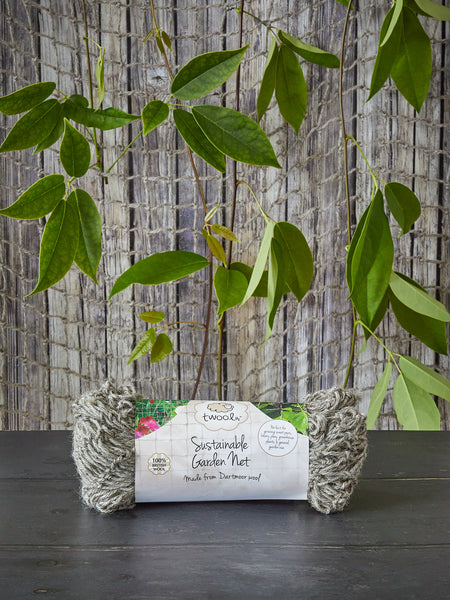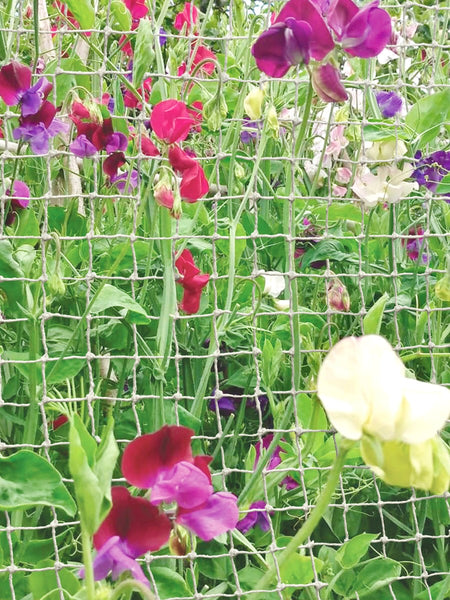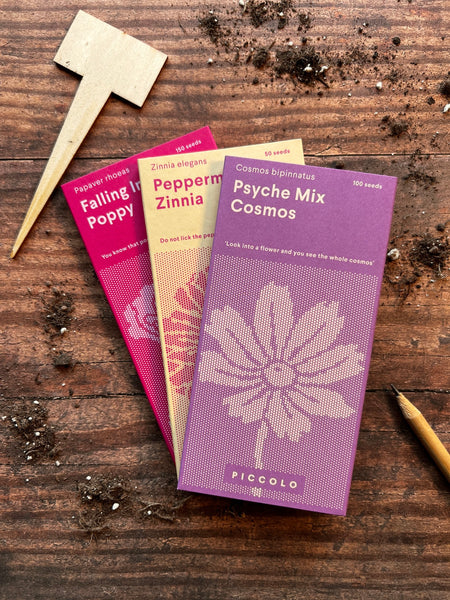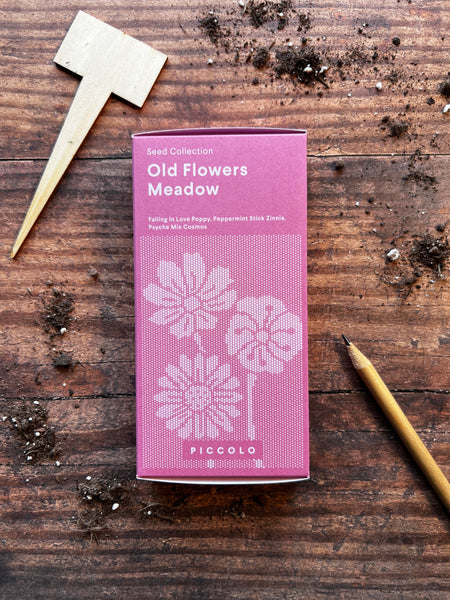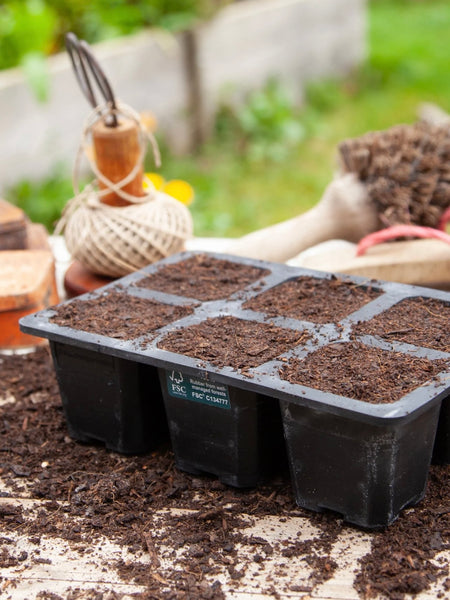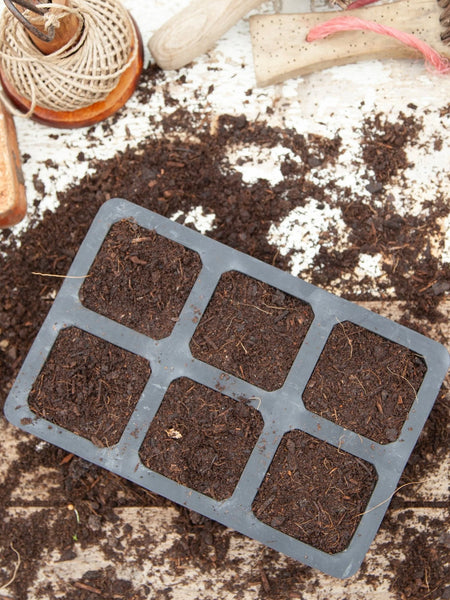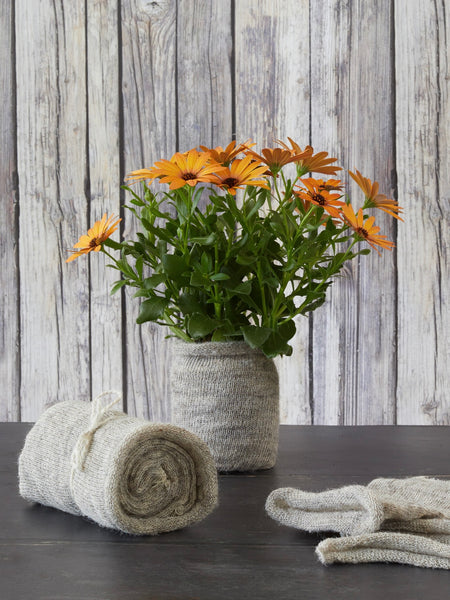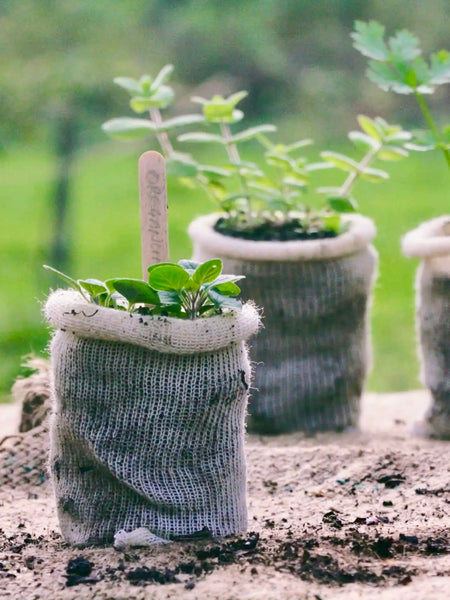April is one of the most joyful and uplifting months in the garden. Days are longer, temperatures increase steadily, and it finally feels like the year is gaining momentum. Even when April begins cold, grey, and wet, it ends with a flurry of fresh leaves, delicate blossoms, and strident flowers. Spring is now an invincible force. Our balconies, gardens, parks, and allotments are reborn, everything seems possible, and the last vestiges of winter are banished.
This is just as well since it’s one of the busiest months of the year for gardeners and the first time many of us will spend a lot of time in our gardens. There's much to do, but enjoying the process and pausing to savour every fleeting, exciting development is important. I try to do something in the garden, however small, every day. This might involve opening up the greenhouse, sowing a tray of seeds, planting a pot with lily bulbs or deadheading the daffodils as they fade. Just half an hour spent in the garden each day will soon achieve results and lift your spirits. However, don’t let the odd warm, sunny spell trick you into planting out summer bedding or other tender plants. It’s still much too early.
If you have time on your hands, use it to reacquaint yourself with your garden. Take an early morning walk to see what’s growing, enjoy a tea break on the patio and listen to the birds singing. Feel the warm sun on your face and breathe in the delicious scent of spring flowers. Let yourself get carried away by dreaming up ideas for your summer garden.

If you’re lacking inspiration or don’t have a garden of your own, visit an open garden. Many host spectacular tulip festivals during April and May. There will be beautiful trees and carpets of spring flowers to enjoy. These will fire your imagination and motivate you to try something new and different.
April at a Glance
Plan - summer bedding displays, spring-flowering bulbs to order for autumn delivery, your first barbecue, flower shows and open gardens to visit.
Sow - half-hardy annual flower and vegetable seeds inside, hardy annuals and vegetables outside.
Plant - dahlia tubers, lily bulbs, gladioli and begonia corms, container-grown perennials, roses, clematis, trees and shrubs.
Prune - tender plants where foliage has been left on over winter for protection. Epimediums and semi-evergreen ferns should have their old leaves cleared away by now.
Feed - house plants, citrus trees, overwintered brassicas, and perennial borders if not already done.
Harvest - bunches of daffodils, tulips, ranunculus and anemones, the first asparagus tips, broad beans, Brussels sprouts, spring cabbage, cauliflower, purple sprouting, turnips, kale, leeks, lettuce, radishes, the first rhubarb stems, spinach, sprouting broccoli (a favourite of mine!) and turnips.
Make simple arrangements of tulips and fruit tree blossoms using a flower frog, rhubarb jams and crumbles, wild garlic pesto, cauliflower cheese, and crunchy slaws using cabbage and radish.
Buy - seed compost, plant labels, new pots and containers for summer planting, plug plants to grow on under glass, rooted dahlia and coleus cuttings, liquid feed for house plants, and new garden furniture.
Enjoy longer days, warmer weather, walks in the countryside or along the coast.
Visit - open gardens hosting tulip festivals and those with fine collections of trees, rhododendrons and azaleas. Churchyards are often filled with flowering trees and wildflowers in spring. Plant fairs begin in earnest, providing opportunities to combine a garden visit with the best kind of shopping.

Indoors
- If you’re new to growing houseplants, now is a great time to start. As the weather outside improves and we switch off our central heating, conditions become much easier for growing indoors. Your local plant shop, garden centre or nursery will be brimming with fresh stock to choose from.
- Houseplants make a great Easter gift for friends and family who don’t like chocolate (yes, those people exist!). Buy them as close to the event as possible and don't let them catch a chill in transit. Cold draughts can cause leaves to turn yellow and drop later.
- Brighter, lighter, longer days and warmer temperatures mean that established houseplants will start growing again now. If you have any positioned on a bright, sunny windowsill, be sure they are happy there. Some foliage plants scorch easily, particularly those with dark green leaves. At the first sign of scorching - usually identified by crisp brown edges or blotches on the leaves - move the plant back from the window a few centimetres.
- Now is the time to begin feeding and watering more regularly. Feed plants once a week with a good-quality houseplant fertiliser and water them each time the compost surface in the pot feels dry to the touch. Avoid plants standing in water for too long—pour away any water they’ve not soaked up after an hour.
- If you are growing citrus trees—for example, oranges and lemons—start giving them a high-nitrogen fertiliser. This will encourage healthy new growth. It’s still too early to put them outside, but move them to the brightest spot you can find indoors.
- If any of your houseplants have become rootbound, then now is the time to move them into a slightly larger pot or container. You can tell if a plant is rootbound by gently tapping the pot on a firm surface and lifting the plant out. If many roots are visible on the outside surface of the rootball, then you probably need to find a new pot that’s around 2cm bigger in diameter. If the roots have started to spiral around the bottom of the pot, then it’s helpful to tease them apart gently so that they’re encouraged to grow into the new compost. Always use fresh, peat-free compost for repotting, and avoid disturbing the roots too much.
- Seedlings grown on windowsills will quickly grow towards the light. Be sure to turn trays or pots daily to prevent young plants from becoming tall and lanky. Believe it or not, stroking your seedlings gently, as you might a cat, encourages them to remain shorter and stronger - the action mimics a natural breeze and promotes firmer tissue and stockier growth.
- Cyclamen and amaryllis that flowered at Christmas may start to die down this month. Stop watering and let the remaining foliage die back. Once the bulbs are completely dry, remove them from the old compost and store them in a cool, dry, dark place until autumn. A cupboard is fine, provided there’s some ventilation.

Potting Shed & Greenhouse
- It only takes a few hours of sun for temperatures in a greenhouse or shed to soar before plummeting again overnight. Generally speaking, plants don’t enjoy dramatic temperature fluctuations, so take steps to keep your greenhouse, shed, porch or conservatory cool and well-ventilated during the day and frost-free at night.
- Open your greenhouse doors and windows on warm sunny days. Damp down paths (sprinkle with water) if it’s warm, but only first thing in the morning. Too much humidity overnight can cause problems with moulds and diseases.
- Unless you plan on supplying your family and friends with baby plants, don’t be tempted to sow too many seeds of the same variety at once. If you’re sowing newly purchased, good-quality seeds, your success rate should be high. Work on the worst-case scenario that 10-20% won’t germinate and keep the remaining seeds back for future sowings. Most seeds will stay fresh for 2-3 years after purchase, and some for considerably longer.
- ‘Pricking out’ is the practice of moving seedlings from the container in which you sowed them to their next home, which might be an individual pot or modular tray. Modules take up less space than pots, but young plants will likely outgrow them quickly. The choice is all about how much space you have and how fast your plants are growing. Ease seedlings out of the compost using a dibber or rigid plant label whilst trying to protect as many of the fragile roots as possible. Handle by the ‘seed’ (first) leaves and never by the roots or stem. Pop into a little hole made in the next pot or module of compost and ease the roots in. Avoid the temptation to firm seedlings in. Watering gently with a small watering can should adequately settle the compost around the roots.
- Anyone who owns a greenhouse will know there’s never enough space inside. April is often the worst month for congestion: many seedlings and young plants are at an advanced stage, yet too vulnerable to survive outside. Gardeners must employ strategic skills to reassess what can be held back, moved on or repositioned. It’s a game of sorts! If you are blessed with a cold frame, hardier plants can be transferred there until the danger of frost has completely passed.
- If you plan on growing dahlias, lilies, gladioli and other summer-flowering tubers and bulbs, now is the time to get them going. You can pot up dahlia tubers in peat-free compost and start them indoors, on a windowsill, porch or greenhouse. By the end of May, the shoots should be around 20cm tall, and the dahlias will be ready to plant out following a period of ‘hardening off’ (getting accustomed to outdoor conditions). You’ll find lots more information about growing dahlias here.
- You can plant lilies and gladioli in the ground or pots. I like to grow them in clumps of 5, 6, 10, or 12. This not only creates more impact, but it also makes supporting them easier.
Terrace & Balcony
- If you didn’t have time to plant a pot or planter with bulbs and spring flowers in the autumn, don’t despair; you can create an instant display using containerised plants. This pop of seasonal colour should last until the end of May, when you’ll be ready to replant for summer.
- Irrigate containers planted with trees, shrubs, bulbs and spring-flowering annuals with a watering can or hose. Although it’s tempting to imagine that natural rainfall will do the job for you, it rarely does. A good soaking once a week should be sufficient during a dry spell.
- Potatoes can be grown very successfully in large containers. A tub 45cm deep and 40cm wide can accommodate two seed potatoes and produce a decent crop of 20+ spuds. Get your seed potatoes in now, especially if you live in an urban area where the temperature is a little warmer.
- If your paths, decks, and paved areas have become green and slippery over winter, choose a fine day to clean them using a jet washer or hot water and a stiff broom. Avoid using chemical cleaners, as these may leach into the soil and damage surrounding plants.
- Remove the covers from your garden furniture and give each piece a good brush to remove debris, rust stains, and spider webs. Wooden furniture left uncovered over winter will look great if you scrub it with a scrubbing brush soaked in hot, soapy water. Wear clothes you don’t mind getting dirty, or cover up with a gardening apron. When the job is done, bring out the seat cushions and take a moment to relax.

Flower Garden
- Sow hardy annuals, including wildflower seed mixtures, on patches of prepared ground. Seed can be sown in rows and then thinned, or broadcast and firmed in gently. Take care to remove all perennial weeds and as many annual weeds as you can before planting, as, later on, it will be tricky to distinguish between the seedlings you want and those you don’t.
- We all feel differently about weeding. I enjoy it; others find it a mind-numbing chore. My philosophy is that it has to be done, so I may as well take pleasure in it. Everything that makes it a great time to plant also creates the perfect conditions for weeds to grow. You'll be invincible with a good kneeler, a sharp trowel, and a few favourite weeding tools.
- Knowing what’s a weed and what’s not is tricky. Experienced gardeners can spot a weed - a plant growing where we don’t want it to grow - from a mile off. However, it’s not apparent to everyone. In most cases, weeds only become a severe nuisance once they start to flower and set seed. If in doubt, leave the seedling or shoot to develop until it’s obvious whether it’s a friend or foe. Take your time, and you’ll soon start to recognise what’s a weed and what’s not.
- April is an excellent month for planting, particularly plants bought in containers. The soil is now relatively warm, and rain is still frequent. Trees, shrubs, roses, and perennials planted in the ground now will have plenty of time to establish their roots before summer. If the ground is very wet, it’s better to wait a few days before planting. Avoid standing on waterlogged soil, as this will squeeze out the air and make it hard for plants to grow.
- Put in plant supports at the same time as you’re planting - they’ll be invisible by summer, which is precisely how you want them to be. Use stakes and ties, canes and string, or specially-designed plant supports, depending on what you’re supporting. The earlier you act, the easier the job will be.
- If you sowed sweet peas in autumn, then now is the time to plant the seedlings outside. If you didn’t get around to it last year, there’s still time to sow in April—plant seeds straight in the ground or in deep pots filled with compost. Extra heat is not required at this time of year, but good light is essential to stop the young plants from becoming weak and lanky. Pinch out the growing tips when the seedlings reach 7-10cm tall. This will encourage stronger and more branched plants.
- Continue deadheading spring-flowering bulbs by snapping off the heads between your thumb and forefinger. Deadheading encourages plants to put all their energy back into the bulb rather than producing seeds.

Trees, Shrubs & Lawns
- Most major pruning jobs should now be completed. Before tidying up shrubs, trees and hedges, check that no birds are nesting nearby. If you suspect birds are nesting, delay further pruning until the nest has been completely abandoned in late summer or early autumn. Ill-timed pruning can disturb nests and scare off parent birds, leaving chicks and unhatched eggs unattended.
- Lawns will start growing strongly now. If you haven't managed an initial cut yet, grasp the opportunity of a warm, dry day, as they can be few and far between in April. Keep the blades of your lawnmower high until May, lowering them over time to get a closer cut. Do not mow areas of grass where bulbs have been flowering until all the foliage has died away. This could be as late as midsummer.
- Winter rain will have leached nutrients from the soil, so now is the time to feed your lawn. If you plan on doing lawn maintenance such as moss control, raking, aerating, or scarifying, apply your lawn fertiliser afterwards. Do not feed if you’re trying to encourage perennial wildflowers to establish in the grass: poor soil reduces the vigour of grasses, allowing other plants to establish.
- Aerate your lawn using a garden fork or hollow-tine aerator to ease compaction and let the grass breathe. If possible, try to finish by the middle of the month.
- Now is the time to start a new lawn using turf or seed. The soil will be warm enough to help your grass establish, and April showers should take care of the watering.
Kitchen Garden & Allotment
- Your vegetable plot should now be ready for sowing and planting. If you delayed digging, cultivating and preparing until the weather improved, April is the time to catch up.
- If you planned ahead, you could harvest asparagus, broad beans, Brussels sprouts, spring cabbage, cauliflower, purple sprouting, turnips, kale, leeks, lettuce, radishes, rhubarb, spinach, sprouting broccoli (a favourite of mine!), and turnips in April.
- Now is the time to sow many vegetable and herb seeds, including beetroot, broad beans, Brussels sprouts, calabrese, carrots, cauliflowers, French beans, kale, leeks, lettuce, mint, parsley, peas, radishes, spinach, summer cabbages and turnips. These can all be sown outdoors in shallow drills. If the weather is cold and wet, delay sowing until the weather warms up. If the weather is warm and dry, give the ground a good soaking every week to encourage your seedlings to get their roots down deep.
- Plant early and mid-season potatoes early in the month. (Many gardeners allow their ‘seed’ potatoes to sprout indoors before planting outside - a process called ‘chitting’). Main-crop potatoes can wait until later in April. Living by the coast, I like to add seaweed to the bottom of my trenches. As the seaweed rots, it provides the potato plants with a great food source. Protect emerging shoots with fleece if frost is forecast.
- If you are lucky enough to have an asparagus bed, you’ll be ready to start cropping at some point this month. The spears are ready when they are about 20cm tall. Cut them just below the soil's surface with a sharp knife and eat them as soon as possible - on the same day if you can.
- Stake sprouting broccoli and kale plants as the plants get taller and more top-heavy. A spring gale can very easily blow them over. Wood pigeons will nibble the leaves and developing flower heads unless protected by netting.
- If you grow fruit trees, mulching around their bases will suppress weeds and keep the ground moist. Most trees benefit from regular mulching as they develop better without competition for nutrients and water. If you planted bare-rooted fruit trees in winter, water them thoroughly at least once a week for the first year to help establish a good root system.
- Take advantage of the first sunny weekend in April to spruce up your shed. A lick of paint or a coat of preservative will smarten it up and protect the wood from the elements for another year. It’s also a good time to empty everything out, clean it, and reorganise. It’s incredible how much stuff you accumulate in a shed over a year!

Wildlife Garden
- Deciduous climbers and shrubs will be coming into leaf now. Watch how bluetits, sparrows, ring-necked parakeets and wood pigeons feast on the tender shoots as they emerge. Don't worry; there will be plenty to go around: you won't miss a few leaves here and there.
- Spring-flowering bulbs will be surging through the ground. Wander in meadows peppered with wild daffodils (Narcissus pseudonarcissus), cowslips (Primula veris) and snake's head fritillaries (Fritillaria meleagris). In the woods, you'll notice carpets of English bluebells (Hyacinthoides non-scripta) starting to bloom. Pick wild garlic (Allium ursinum) to make a delicious wild garlic pesto, add the torn leaves to stir-fries and cheese scone recipes, and use translucent white flowers to garnish a salad.
- The breeding season for garden birds is now in full swing. Willow warblers, house martins, swifts and swallows will also be arriving from Africa to spend the summer on our shores. It's not too late to put up a bird box since most females will have several clutches of eggs between now and summer. Situate your bird box at a safe distance from humans and predators such as cats. Orientate the entrance towards the North or North East to protect them from the prevailing weather.
- April is a great month to create a miniature wetland, marsh or bog garden. Dig a hollow about 45-60cm deep in an open spot, leaving a shallow shelf around the edge, then line it with a flexible rubber liner. Make a few holes in the liner in the deepest part of the hollow to allow excess water to drain away; otherwise, it will become a pond. Backfill with the removed soil and soak the area thoroughly to help nature take its course. Fill with plants that enjoy having wet feet: gardeners call these 'marginals' because they grow at the edges of ponds, lakes, canals and rivers. Remember that marginals are vigorous when happy, so don't plant too densely. During dry spells later in the year, keep moisture levels high by watering with a can or hose.


